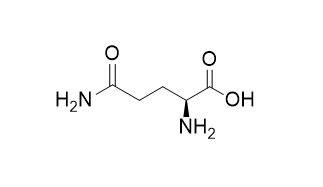L-Glutamine
L-Glutamine prevents acetaldehyde-induced disruption of the tight junction and increase in the paracellular permeability in Caco-2 cell monolayer by an EGF receptor-dependent mechanism. It prevents oxidant- or endotoxin-induced death of neonatal enterocytes.
Inquire / Order:
manager@chemfaces.com
Technical Inquiries:
service@chemfaces.com
Tel:
+86-27-84237783
Fax:
+86-27-84254680
Address:
1 Building, No. 83, CheCheng Rd., Wuhan Economic and Technological Development Zone, Wuhan, Hubei 430056, PRC
Providing storage is as stated on the product vial and the vial is kept tightly sealed, the product can be stored for up to
24 months(2-8C).
Wherever possible, you should prepare and use solutions on the same day. However, if you need to make up stock solutions in advance, we recommend that you store the solution as aliquots in tightly sealed vials at -20C. Generally, these will be useable for up to two weeks. Before use, and prior to opening the vial we recommend that you allow your product to equilibrate to room temperature for at least 1 hour.
Need more advice on solubility, usage and handling? Please email to: service@chemfaces.com
The packaging of the product may have turned upside down during transportation, resulting in the natural compounds adhering to the neck or cap of the vial. take the vial out of its packaging and gently shake to let the compounds fall to the bottom of the vial. for liquid products, centrifuge at 200-500 RPM to gather the liquid at the bottom of the vial. try to avoid loss or contamination during handling.
J Hematol Oncol.2018, 11(1):112
Food Chem.2017, 228:301-314
Molecules.2024, 29(5):1171.
Medicinal Chemistry Research 2021, 30:1117-1124.
Molecules.2020, 25(9):2111.
Immunopharmacol Immunotoxicol.2024, 46(4):496-508.
Int J Nanomedicine.2024, 19:1683-1697.
J Nat Med.2022, 76(1):59-67.
Processes2021, 9(11),2065.
Mol Biol Rep.2024, 51(1):117.
Related and Featured Products
American Journal of physiology. Gastrointestinal and Liver Physiology, 01 Sep 2004, 287(3):G510-7。
L-Glutamine ameliorates acetaldehyde-induced increase in paracellular permeability in Caco-2 cell monolayer.[Reference:
WebLink]
METHODS AND RESULTS:
Role of L-Glutamine in the protection of intestinal epithelium from acetaldehyde-induced disruption of barrier function was evaluated in Caco-2 cell monolayer. L-Glutamine reduced the acetaldehyde-induced decrease in transepithelilal electrical resistance and increase in permeability to inulin and lipopolysaccharide in a time- and dose-dependent manner; d-glutamine, L-aspargine, L-arginine, L-lysine, or L-alanine produced no significant protection. The glutaminase inhibitor 6-diazo-5-oxo-L-norleucine failed to affect the L-Glutamine-mediated protection of barrier function. L-Glutamine reduced the acetaldehyde-induced redistribution of occludin, zonula occludens-1 (ZO-1), E-cadherin, and beta-catenin from the intercellular junctions. Acetaldehyde dissociates occludin, ZO-1, E-cadherin, and beta-catenin from the actin cytoskeleton, and this effect was reduced by L-Glutamine. L-Glutamine induced a rapid increase in the tyrosine phosphorylation of EGF receptor, and the protective effect of L-Glutamine was prevented by AG1478, the EGF-receptor tyrosine kinase inhibitor.
CONCLUSIONS:
These results indicate that L-Glutamine prevents acetaldehyde-induced disruption of the tight junction and increase in the paracellular permeability in Caco-2 cell monolayer by an EGF receptor-dependent mechanism.
Diabetologia, 1981, 63(2):112-118.
The stimulus-secretion coupling of amino acid-induced insulin release. IV. Ionic response to L-Leucine and L-Glutamine.[Reference:
WebLink]
METHODS AND RESULTS:
L-Glutamine enhances insulin release evoked by L-leucine in isolated rat pancreatic islets. The enhancing action of L-Glutamine, which is a rapid but steadily increasing and not rapidly reversible phenomenon is not attributable to any major change in either K+ or Ca2+ outflow from the islet cells. It coincides with an apparent increase in Ca2+ inflow rate and, hence, with Ca accumulation in the islets. The initial ionic response to L-leucine is not qualitatively altered by the presence of L-Glutamine. In their combined capacity to stimulate 45Ca net uptake in the islets, L-Glutamine can be replaced by L-asparagine but not by L-glutamate, whereas L-leucine can be replaced by L-norvaline or L-isoleucine, but not by L-valine, glycine or L-lysine. Such a specificity is identical to that characterizing the effect of these various amino acids upon insulin release.
CONCLUSIONS:
It is postulated that the release of insulin evoked by the combination of L-leucine and L-Glutamine involves essentially the same remodelling of ionic fluxes as that evoked by other nutrient secretagogues with, however, an unusual time course for the functional response to L-Glutamine.
Amino Acids, 2009, 37(1):131-142.
L-Glutamine or L-alanyl-L-glutamine prevents oxidant- or endotoxin-induced death of neonatal enterocytes.[Reference:
WebLink]
This study tested the hypothesis that L-Glutamine (Gln) or L-alanyl-L-Glutamine (Ala-Gln) prevents oxidant- or endotoxin-induced death of neonatal enterocytes. Enterocytes of neonatal pigs rapidly hydrolyzed Ala-Gln and utilized Gln.
METHODS AND RESULTS:
To determine whether Gln or Ala-Gln has a cytoprotective effect, IPEC-1 cells were cultured for 24 h in Gln-free Dulbecco’s modified Eagle’s-F12 Ham medium containing 0, 0.5, 2.0 or 5.0 mM Gln or Ala-Gln, and 0, 0.5 mM H2O2 or 30 ng/ml lipopolysaccharide (LPS). Without Gln or Ala-Gln, H2O2- or LPS-treated cells exhibited almost complete death. Gln or Ala-Gln at 0.5, 2 and 5 mM dose-dependently reduced H2O2- or LPS-induced cell death by 14, 54 and 95%, respectively, whereas D-glutamine, alanine, glutamate, ornithine, proline, glucosamine or nucleosides had no effect. To evaluate the effectiveness of Gln or Ala-Gln in vivo, 7-day-old piglets received one-week oral administration of Gln or Ala-Gln (3.42 mmol/kg body weight) twice daily and then a single intraperitoneal injection of LPS (0.1 mg/kg body weight); piglets were euthanized in 24 and 48 h to analyze intestinal apoptotic proteins and morphology. Administration of Gln or Ala-Gln to LPS-challenged piglets increased Gln concentrations in small-intestinal lumen and plasma, reduced intestinal expression of Toll-like receptor-4, active caspase-3 and NFkB, ameliorated intestinal injury, decreased rectal temperature, and enhanced growth performance. These results demonstrate a protective effect of Gln or Ala-Gln against H2O2- or LPS-induced enterocyte death.
CONCLUSIONS:
The findings support addition of Gln or Ala-Gln to current Gln-free pediatric amino acid solutions to prevent intestinal oxidative injury and inflammatory disease in neonates.



